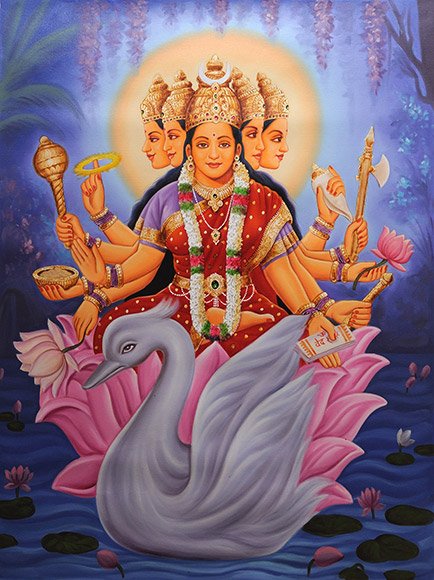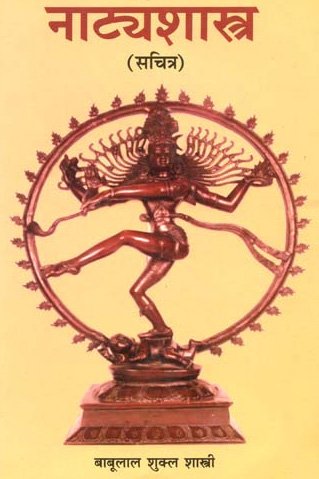Gira, Girā: 21 definitions
Introduction:
Gira means something in Hinduism, Sanskrit, Buddhism, Pali, Marathi, Jainism, Prakrit. If you want to know the exact meaning, history, etymology or English translation of this term then check out the descriptions on this page. Add your comment or reference to a book if you want to contribute to this summary article.
Images (photo gallery)
In Hinduism
Purana and Itihasa (epic history)
Source: Wisdom Library: Varāha-purāṇaGirā (गिरा).—Name of a river originating from Vindhya, a holy mountain (kulaparvata) in Bhārata, according to the Varāhapurāṇa chapter 85. There are settlements (janapada) where Āryas and Mlecchas dwell who drink water from these rivers.
Bhārata is a region south of Hemādri, once ruled over by Bharata (son of Ṛṣabha), whose ancestral lineage can be traced back to Svāyambhuva Manu, who was created by Brahmā, who was in turn created by Nārāyaṇa, the unknowable all-pervasive primordial being.
The Varāhapurāṇa is categorised as a Mahāpurāṇa, and was originally composed of 24,000 metrical verses, possibly originating from before the 10th century. It is composed of two parts and Sūta is the main narrator.
Source: Cologne Digital Sanskrit Dictionaries: The Purana IndexGira (गिर).—A son of Sāraṇa.*
- * Vāyu-purāṇa 96. 165.

The Purana (पुराण, purāṇas) refers to Sanskrit literature preserving ancient India’s vast cultural history, including historical legends, religious ceremonies, various arts and sciences. The eighteen mahapuranas total over 400,000 shlokas (metrical couplets) and date to at least several centuries BCE.
Chandas (prosody, study of Sanskrit metres)
Source: Shodhganga: a concise history of Sanskrit Chanda literatureGirā (गिरा) is the name of a Sanskrit metre (chandas) defined by Bharata, to which Hemacandra (1088-1173 C.E.) assigned the alternative name of Śapharikā in his auto-commentary on the second chapter of the Chandonuśāsana. Hemacandra gives these alternative names for the metres by other authorities (like Bharata), even though the number of gaṇas or letters do not differ.

Chandas (छन्दस्) refers to Sanskrit prosody and represents one of the six Vedangas (auxiliary disciplines belonging to the study of the Vedas). The science of prosody (chandas-shastra) focusses on the study of the poetic meters such as the commonly known twenty-six metres mentioned by Pingalas.
Natyashastra (theatrics and dramaturgy)
Source: Wisdom Library: Nāṭya-śāstraGirā (गिरा) is the name of a meter belonging to the Gāyatrī class of Dhruvā (songs) described in the Nāṭyaśāstra chapter 32:—“the metre which has in its feet of six syllables the first three and the fifth short, is girā”.

Natyashastra (नाट्यशास्त्र, nāṭyaśāstra) refers to both the ancient Indian tradition (shastra) of performing arts, (natya—theatrics, drama, dance, music), as well as the name of a Sanskrit work dealing with these subjects. It also teaches the rules for composing Dramatic plays (nataka), construction and performance of Theater, and Poetic works (kavya).
Shaivism (Shaiva philosophy)
Source: academia.edu: Religious Inclusivism in the Writings of an Early Modern Sanskrit Intellectual (Shaivism)Girā (गिरा) refers to the “words” (of the foremost scriptures).—Not only does Appaya believe that Advaita is the underlying teaching of Śrīkaṇṭha’s commentary; he also takes it to be the final word of all Śaivāgamas and actually of all Hindu scriptures, as he himself solemnly declares at the beginning of the Śivārkamaṇidīpikā: “The culminating point (niṣṭhā) of the words of the foremost scriptures [i.e., śrutiśikhara-girā], āgamas as well as all [other] compositions, from the multitude of Purāṇas to smṛti texts such as the Mahābhārata and so forth, is in non-duality alone (advaita eva); the Brahmasūtras too appear to the discerning ones to have their rest in [non-duality] alone [and] nothing but that [non-duality] was accepted by ancient ācāryaratnas led by Śaṅkara”

Shaiva (शैव, śaiva) or Shaivism (śaivism) represents a tradition of Hinduism worshiping Shiva as the supreme being. Closely related to Shaktism, Shaiva literature includes a range of scriptures, including Tantras, while the root of this tradition may be traced back to the ancient Vedas.
Yoga (school of philosophy)
Source: ORA: Amanaska (king of all yogas): A Critical Edition and Annotated Translation by Jason BirchGira (गिर) refers to a “voice”, according to Hemacandra’s Yogaśāstra (12.22-25): “Always sitting comfortably in an isolated, very clean and beautiful place, [the Yogin] whose whole body has become relaxed from the top of his crown to the tips of his feet, [so that] even [if he is] looking at a beautiful form [or] even hearing a voice (gira), melodious and pleasing to the mind, even smelling lovely smells, even eating agreeable tastes, even touching soft things [or] even not restraining the activity of his mind, his detachment is upheld and his confusion over sense objects is destroyed forever more. [...]”.

Yoga is originally considered a branch of Hindu philosophy (astika), but both ancient and modern Yoga combine the physical, mental and spiritual. Yoga teaches various physical techniques also known as āsanas (postures), used for various purposes (eg., meditation, contemplation, relaxation).
Languages of India and abroad
Pali-English dictionary
Source: BuddhaSasana: Concise Pali-English Dictionarygirā : (f.) word; utterance.
Source: Sutta: The Pali Text Society's Pali-English DictionaryGirā, (Vedic gir & gēr, song; gṛṇāti to praise, announce gūrti praise=Lat. grates “grace”; to *ger or *gǔer, see note on gala) utterance (orig. song, important utterance, still felt as such in older Pāli, therefore mostly poetical), speech, words D.III, 174; Sn.350, 632, 690, 1132; Dh.408; Th.2, 316, 402; Vv 5018 (=vācā VvA); Dhs.637, 720; DhsA.93; DA.I, 61 (aṭṭhaṅgupetaṃ giraṃ), J.II, 134. (Page 251)

Pali is the language of the Tipiṭaka, which is the sacred canon of Theravāda Buddhism and contains much of the Buddha’s speech. Closeley related to Sanskrit, both languages are used interchangeably between religions.
Marathi-English dictionary
Source: DDSA: The Molesworth Marathi and English Dictionarygirā (गिरा).—m A measure of length, 1½ tasū. 2 C Usually giṛhā.
--- OR ---
gīra (गीर).—m (Commonly gara) Pulp, pith, kernel, marrow, crumb &c.
--- OR ---
gīra (गीर).—ind (Sometimes from sometimes from P) An affix to nouns, implying an agent; as tagādagīra, ābadāgīra.
Source: DDSA: The Aryabhusan school dictionary, Marathi-Englishgirā (गिरा).—m A measure of 1½ tasū. See giṛhā Speech.
--- OR ---
gīra (गीर).—m Pulp, marrow, kernel.
Marathi is an Indo-European language having over 70 million native speakers people in (predominantly) Maharashtra India. Marathi, like many other Indo-Aryan languages, evolved from early forms of Prakrit, which itself is a subset of Sanskrit, one of the most ancient languages of the world.
Sanskrit dictionary
Source: DDSA: The practical Sanskrit-English dictionaryGirā (गिरा).—
1) Speech, speaking, language, voice.
2) Praise.
Source: Cologne Digital Sanskrit Dictionaries: Edgerton Buddhist Hybrid Sanskrit DictionaryGirā (गिरा).—(= Pali, Sanskrit Lex. id.; Sanskrit gir, f.), voice, speech: Saddharmapuṇḍarīka 152.2 girām, acc. sg.; Mahāvastu i.163.16 -girāhi, inst. pl.; ii.143.23 girāṃ acc. sg.; Lalitavistara 360.15 girā, n. sg. (all verses). See also next, -giri-.
Source: Cologne Digital Sanskrit Dictionaries: Shabda-Sagara Sanskrit-English DictionaryGirā (गिरा).—f.
(-rā) Speech. gṝ to sound, ka and ṭāp affs.
--- OR ---
Gira (गिर).—mfn. (-riḥ-riḥ-ri) Venerable, respectable worshipful. m.
(-riḥ) 1. A mountain, a hill. 2. A wooden ball with which children play. 3. A. disease of the eyes. f.
(-riḥ) 1. Swallowing. 2. A small rat, a mouse. 3. A title given to one order of the Dasnami Gosains. E. gṝ to swallow, &c. i Unadi aff.
Source: Cologne Digital Sanskrit Dictionaries: Benfey Sanskrit-English DictionaryGira (गिर).—[-gira], A substitute for giri, when latter part of a comp. adv., e. g. anu-gira + m, Along the mountain, [Raghuvaṃśa, (ed. Stenzler.)] 13, 49.
Source: Cologne Digital Sanskrit Dictionaries: Cappeller Sanskrit-English DictionaryGira (गिर).—1. (—°) = 2 gir.
--- OR ---
Gira (गिर).—2. (—°) = seq.
Source: Cologne Digital Sanskrit Dictionaries: Monier-Williams Sanskrit-English Dictionary1) Gira (गिर):—[from gir] 1. gira ifc. = gir1, speech, voice, [Varāha-mihira’s Bṛhat-saṃhitā xxxii, 5]; (ā1) f. ([gana] ajādi, [Gaṇaratna-mahodadhi 41 [Scholiast or Commentator]]) idem, [cf. Lexicographers, esp. such as amarasiṃha, halāyudha, hemacandra, etc.]
2) Girā (गिरा):—[from gir] 2. girā [instrumental case] of 1. gir.
3) Gira (गिर):—[from gir] 2. gira mfn. idem, [Vopadeva xxvi, 32.]
4) [from gir] 3. gira ifc. = ri (e.g. anu-giram), [Pāṇini 5-4, 112.]
Source: Cologne Digital Sanskrit Dictionaries: Yates Sanskrit-English DictionaryGirā (गिरा):—(rā) 1. f. Speech.
[Sanskrit to German]
Sanskrit, also spelled संस्कृतम् (saṃskṛtam), is an ancient language of India commonly seen as the grandmother of the Indo-European language family (even English!). Closely allied with Prakrit and Pali, Sanskrit is more exhaustive in both grammar and terms and has the most extensive collection of literature in the world, greatly surpassing its sister-languages Greek and Latin.
Prakrit-English dictionary
Source: DDSA: Paia-sadda-mahannavo; a comprehensive Prakrit Hindi dictionaryGirā (गिरा) in the Prakrit language is related to the Sanskrit word: Gir.
Prakrit is an ancient language closely associated with both Pali and Sanskrit. Jain literature is often composed in this language or sub-dialects, such as the Agamas and their commentaries which are written in Ardhamagadhi and Maharashtri Prakrit. The earliest extant texts can be dated to as early as the 4th century BCE although core portions might be older.
Kannada-English dictionary
Source: Alar: Kannada-English corpusGira (ಗಿರ):—[noun] = ಗಿದ್ದ [gidda].
--- OR ---
Gira (ಗಿರ):—
1) [noun] any of the celestial objects with apparent motion (as the sun, Mercury, Venus, Mars, Jupiter, etc.).
2) [noun] an intense desire.
Kannada is a Dravidian language (as opposed to the Indo-European language family) mainly spoken in the southwestern region of India.
See also (Relevant definitions)
Starts with (+82): Gira-gira, Gira-girachiya, Gira-Kana-Kara-Dini-Dishi, Girabadanem, Girabhi, Giracatanem, Girada, Giradavara, Giradhara gosvamin, Giradi, Giradol, Giragadara, Giragatanem, Giragate, Giragatte, Giragga, Giraggasamajja, Giraginda, Giragira, Giragirachee.
Ends with (+81): Abadagira, Agira, Angira, Ankira, Antargira, Antargiribahirgira, Anugira, Apadagira, Aphatagira, Aptagira, Atharvangira, Bahirgira, Baragira, Barhadgira, Bhangira, Bhasmodgira, Brihadgira, Brihangira, Carakhunta Jahagira, Carakhunta-jahagira.
Full-text (+169): Gir, Jadukhora, Giravridh, Vakriman, Gira-gira, Girapura, Savadagara, Jodagari, Abadagiriya, Anugiram, Girarage, Anuddhata, Samgira, Giraukas, Upagiram, Divesalami, Samdarbha, Yushmayant, Bahirgira, Timimgira.
Relevant text
Search found 59 books and stories containing Gira, Girā, Gīra; (plurals include: Giras, Girās, Gīras). You can also click to the full overview containing English textual excerpts. Below are direct links for the most relevant articles:
Garga Samhita (English) (by Danavir Goswami)
Verse 5.1.28 < [Chapter 1 - Advice to Kaṃsa]
Verse 1.1.3 < [Chapter 1 - Description of Śrī-Kṛṣṇa’s Glories]
Verse 6.10.10 < [Chapter 10 - In the Description of the Gomatī River, the Glories of Cakra-tīrtha]
Rig Veda (translation and commentary) (by H. H. Wilson)
Sahitya-kaumudi by Baladeva Vidyabhushana (by Gaurapada Dāsa)
Text 4.90 < [Chapter 4 - First-rate Poetry]
Text 6.5 < [Chapter 6 - Third-rate Poetry and Super-excellent Poetry]
Text 10.233 < [Chapter 10 - Ornaments of Meaning]
Dhammapada (Illustrated) (by Ven. Weagoda Sarada Maha Thero)
Verse 408 - The Story of Venerable Piliṇḍavaccha < [Chapter 26 - Brāhmaṇa Vagga (The Brāhmaṇa)]
Satapatha-brahmana (by Julius Eggeling)
Kāṇḍa VI, adhyāya 5, brāhmaṇa 4 < [Sixth Kāṇḍa]
Kāṇḍa VI, adhyāya 5, brāhmaṇa 2 < [Sixth Kāṇḍa]
Kāṇḍa X, adhyāya 5, brāhmaṇa 1 < [Tenth Kāṇḍa]
Asvalayana-grihya-sutra (by Hermann Oldenberg)

